Vol. 2, Issue 65 - September / October 2016
Posted: Friday 16th September 2016
There will be less talk about classic lightweight rides we have done this summer as I had the misfortune to come off my Colnago on 30 July and ended up in hospital with bruised shoulder, fractured elbow (operated on) and hip which is left to heal by itself. Luckily all on the left side as I am right-handed but it also means that the gears on the bike were not damaged. I have no one to blame but myself as we rode into a shower and I was putting on a rain jacket whilst riding along. I must have hit a bump in the wet road as I hit the tarmac in double quick time.
As I write this we should have been riding in the first UK ride organised for Carpenter cycles by Peter Beddington which started at Shepperton on the River Thames. Peter and his brother have quite a collection of Carpenters, including a rare tandem, and Peter hosts an informative website on Carpenter at www.carpenterbikes.com. Ever since my teenage years I have had a soft spot for the Carpenter marque as some of my (better-off) friends rode them back in the 50s and they were very impressive machines. I can still see in my mind’s eye one member of the Wisbech Wheelers on his immaculate Carpenter with the fashion of the day, i.e. the saddle about one inch above the top tube and the stem as low as it would go. Sadly, Randy is no longer with us. I never managed to find one for myself but Patricia has an Olympic Mass Start and is very impressed with its handling and ride.
The ride would have been nostalgic for both Patricia and for me as we used to ride the Thames towpath quite often when we lived in London prior to moving to Cambridge and the area has many fond memories for us. Sadly, we are sitting at home envying all who attend as the weather is about as good as it gets – Sod’s Law as it is known. On the day, Peter had a good turnout as follows:
| Carpenter: | |
| Jean-Paul Burch | 1962 #5371, (Olympic Massed Start) |
| Peter Kennish | 1959 #5201 (His club bike since new) |
| Greg Folwell | 1952 #4718 (Super Clubman? Very brown) |
| John Goddard | 1951 #4571 (SA Speed Ace, AW hub) |
| Peter Bedingfield | 1949 #4296 (Supalite Special, fixed) |
| John Bedingfield | 1948 #4216 (Super Clubman, fixed – in family from new) |
| Other marques: | |
| Francis Thurmer | 1982 Ken Ryall with original finish |
| Don Clarke | 1957 Stuart Purves, original finish |
| Sonia Bedingfield | 1982 Falcon Ladies frame. Black Diamond says Francis. |
| Janet Bedingfield | MTB of unknown heritage, with hybrid wheels. |
| Our lead-out team: | |
| Bob Johnson | Cinelli. All chrome frame. Gorgeous. |
| Geoff Nagle | Holdsworth. Cyclone? Very pretty. Single speed |
Had we been able to ride Patricia would have taken her 1963 Carpenter Olympic Mass Start which would be very similar to Jean-Paul Burch’s machine. It would have been interesting to look and compare the two as every bike was built to the owner’s specification at that time. Towards the end of the ride the group called in at what had, for many years, been the premises for Carpenter at Surbiton Road, Kingston-upon-Thames, for a picture of Carpenters back at their birthplace.
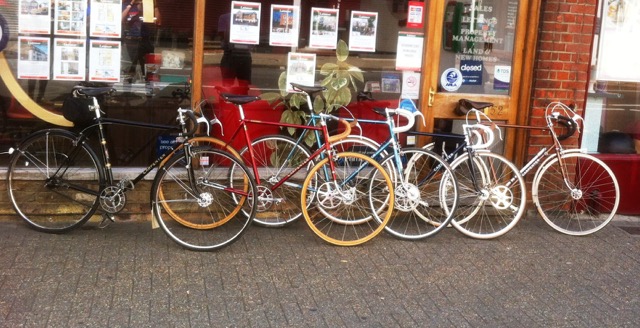
Due to being housebound I have watched more television than normal and luckily the time coincided with the Olympic cycling coverage and it is really amazing what the UK cyclists won. The Trott/Kenny household will soon be able to cover a wall with gold medals. People wonder how the ‘factory’ at Manchester manages to produce so many outstanding competitors. I read an article in a newspaper by ex-athlete Kelly Holmes, who is an Olympic gold medal winner herself. She told how she visited the velodrome to write a piece on life on the Olympic treadmill. She saw healthy, fit looking participants walk through the doors at 9am. She watched them perform to exhaustion level time after time throughout the day until they left at the end looking like zombies drained of all energy. She spoke to the director asking if this was a special high-intensity day to be told that ‘No’ this was what they did for six day a week, every week of the year. I heard an interview with Joanna Rowsell Shand asking how she spent her free time and she explained that on her days off she just curled up on a sofa, being too exhausted to do anything else. Jason Kennywhen interviewed after his final Olympic event repeatedly said he just wanted to rest as he was patently physically exhausted and it showed as they spoke to him.
Some people look for ulterior reasons for the team’s success but they reap the rewards for the unrelenting training they do all the year round and the back-up team manages to get the squad at top level fitness for every Olympic year with a two-year programme devised with nothing else in mind. The way they are financed from the lottery fund is based upon winning enough medals to justify the expense.
It is a week or so since I wrote about my accident and I have progressed in as far as I no longer use a sling for my arm, or a crutch to walk with. I would struggle to ride a conventional lightweight with a ‘diamond’ frame but we are lucky in that we own Airnimal folding bikes which have a semi-‘open’ frame so I am just able to get my leg through the gap. I am slowly building up the miles on this and in one week have progressed from a mile round the block to my longest ride so far of 26 miles. These are all steady miles at about 12mph but it is a start and I am several weeks ahead of the most optimistic predictions for recovery.
Rory O’Brien – The only cockney Irishman in Captivity: David Twitchett
It was around 1953 when I first went into Rory O’Brien’s Manor Park cycle shop. I would have been barely seventeen years old but had already been working as a city office boy since the age of 14 (illegally). I had decided that the time had come to see something of the countryside and that the only affordable way was to cycle. Thus I sought the cheapest possible half decent lightweight for the purpose and Rory sold me a splendid flamboyant Claud Butler Jubilee model, just then newly on the market. Coming from a poverty stricken household and with only an office boy’s salary the machine was, of course, bought on the never as we said at the time. The Victorians more politely called it the “installment system”.
Rory at that time was a well grown-up established businessman, having already served as manager of Claud Butler’s East Ham branch before starting his own shop some years prior to my first visit. So it is difficult to explain the rapport between him and myself – a stripling seventeen year old. He was kind, affable and certainly with the gift of the gab. I cannot now think why I chose his shop for my nearest retailer was E.G Bates of Plaistow, and to get to Rory’s I had to walk straight past Hawkes‘ shop in The Barking Road close by at East Ham. Maybe they had nothing in my price range. I soon joined the local YHA Group and together with those clubmates used to treat Rory’s shop as a second clubroom on a Saturday Morning. “See you up Rory’s” was the cry as we departed our midweek meeting.
In 1956 I had obviously grown somewhat and the Jubilee was too small for me so back to Rory I went for a new 25 inch frame carrying his own label. Being still impecunious it would be his lowest priced model, the “Cadet,” that I bought, once more on the never. I know not how but the order sheet for this frame has survived, written of course in Rory’s own hand. A close inspection of this document will reveal my periodic payments and the extraordinary fact that I ordered a pair of those “Never Ready” battery lamps to be sprayed purple to match the frame!! -Greenhorn that I was. Being the cheapest model I very much doubt that Ephgrave was the builder, although one old timer seeing it recently thought the lugwork looked Ephgrave.
Many years later Rory would tell me that he had a half share in Ephgrave so was more than usually disappointed when Ephgrave died!! I do not know which of Rory’s contacts made my frame but it served me well—countless miles in the Home Counties on Sunday runs and hostel week-ends. At least two Easter tours to the Isle of Wight and back; one tour Westwards to Lands End and back and another Eastwards to Copenhagen and return. The machine fell into disuse when late in 1957 I acquired a lovely girlfriend. Rory rustled up a second hand pre-war Claud Butler shortbase tandem which fitted the bill until my active club days ceased in 1963, My Sundays thereafter were spent in lawn mowing.
However, at about the same time that I ceased club riding I obtained my first Victorian high wheel machine and was soon embroiled in the veteran bike scene. My lovely Liz at about the same time developed a taste for tri-cycling so he worked on her Higgins for me. This meant that I still had use for Rory’s services and skills. From time to time I would pop down to his Romford shop for a job to be done. For a while Rory had the two shops but eventually there was a problem with lease renewal and the Manor Park shop closed. He never had his heart in the Romford shop as he needed there to sell English Perpendicular Style bicycles and children’s machines as well as lightweights. The Manor Park shop was totally for clubmen, and was more to his liking. In fact Rory would have sold out and retired much earlier than he did but kept the Romford shop running for the sake of his brother-in-law Ken Kirby – the other fellow in the shop, I imagine until such time as Ken could retire and collect a pension
Before I return to The Cadet I would like to tell of piece of skill which astounded me. The High wheeler I had acquired was a late pneumatic racing model of extremely light weight. Most of the spokes were missing. At one of the Earls Court shows I persuaded Messr. Richard Johnson and Nephew Ltd. of Derby to make and sell me some extremely long straight spokes of fine gauge. The problems for rebuilding the wheel were immense. The hub was drilled with forty holes but the rim had seventy eight!! I had worked out that with two single spokes the hub could be held central within the rim. That took out two holes in both rim and hub, which left thirty eight holes in the hub and seventy six in the rim. So it was then evident that each remaining hub hole would serve two in the rim. Laced spoking whereby the long spoke passed through the hub and out the other side to rejoin the rim.
That meant kinking the spoke wire somewhere not exactly in the middle as one might first assume and then changing the spoke direction and working out the cross-overs before rejoining the rim on the other side. Confused? I took the problem to Rory. “Ok” he said ”but I will need the forks to true it properly!!” It is here now for any to see. By this time Liz and I were seeing the O’Briens socially from time to time at their house a few streets behind the Romford store, and here in Billericay. We also visited at Bicknacre after their move from Romford. Rory had sold me three bikes during my youth and I recall that I later sold him three in his later years: the first an Edwardian Lea and Francis. In his later years he enjoyed the monthly veteran–cycle club runs, also the seven annual veteran- cycle rallies that I organised here in Billericay. Those events were a less demanding way to stay in touch with the cycling scene.
I eventually sold that ROB Cadet. I was not using it and realised I was being the proverbial dog in a manger, so sold it to a lad who badly wanted it. Instead of using it properly he hacked it around the local streets until he obtained a motorbike and sold the ROB on to another lad or two who did likewise. Eventually I bought it back in a sorry state – flat bars, two left-hand bottom bracket cups etc etc. It went to Rory for sorting out and a respray to the original colour scheme. Thereafter I rode it around the local lanes with the local CTC for a few years or alongside Liz on her Higgins until such time as she could no longer ride and I stopped too. It is still here, now sadly neglected again due my age I’m afraid. After its refurbishment I went to collect it and was taken to one side by Rory. He pointed out the John Bull Safety Speed tyre on the rear wheel, at least fifteen years old, maybe twenty.
He then showed me a new JBSS tyre hanging on his rack. There was still twice the amount of tread on my old tyre as on the new one! “Things ain’t what they used to be” he reminisced. “When I used to open up the shop each morning I was hit by a wonderful smell of oil and rubber. That does not happen now.” I cannot tell anymore about the ROB Cadet than you can glean from the illustrated order form. I know nothing about frame angles and lugsets etc but the illustrations may make them obvious to those who are interested. The pump pegs to the seat tube were not to the rear but at an offset angle. However, my heel never clipped the 18” pump.
Rory was undoubtedly a character. Alert and always with a smile. A real live wire. He told me that once when racing a trike he hit an adverse camber and demolished a bus queue. Sad to tell he ended his days in Severalls hospital at Colchester after his mind went.
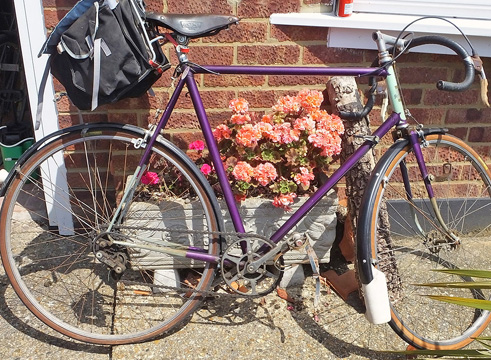
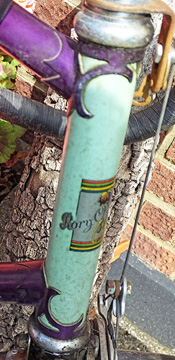
I lived in Herne Hill as a teenager, knew Don Louis, and was a frequent visitor to his shop. This would have been around 1952. In fact at the age of 15 I pestered and pestered my mother to buy me a gorgeous bike that was on show in Don’s shop window. The frame was not Don Louis but built by a visiting frame builder named T J Quick, I believe, and was badged TJQ. Anyway, it was definitely made on Don’s premises and was a real eye-catcher. Don never made frames but did build wheels. Saturday afternoons spent in Don’s shop (and right after the Herne Hill track meets) was absolute mecca for me – it was chock full of us lads checking out the latest gear and drinking Don’s coffee. You could walk out of Don’s shop with the latest ‘Double Clanger’ and he would insist you personally pencilled in the item, amount and your proposed weekly payment into his sales ledger book.
Talk about trust! I don’t think he made much money! I suspect that a lot was stolen as Don allowed ‘customers’ to go behind the counter – there were more of us lads behind the counter than on the actual shop floor! He really was a friendly bloke but would also use foul language when the need arose. As I remember, Don usually rode a flashy, wholly chromium-plated track bike and would accompany some ten or so of us lads on Sunday morning circuits around Dulwich Park, shouting obscenities if we overtook him! Tearing around and emulating our particular hero, e.g. Coppi, Reg Harris or, in my case, Dave Bedwell (I am also quite short!) – we were not popular with the local pedestrians or park wardens! As far as I remember, Don was Welsh and always wore a beret and lived quite near to the shop. I have since heard it said that he (er um!) liked young boys but I and my mates never encountered this.
I often wonder what happened to him, as we moved away from Herne Hill in about 1953 and I lost contact. Now living in France, I did recently acquire a Don Louis bike which I have temporarily converted to a hybrid for use on our local canal towpath and off road rides. My Don Louis is used daily for a trip to the Boulangerie – I call it ‘My Baguette Bike” and I actually enjoy riding it in preference to my 1970’s Raleigh Record Ace and my very modern road machine! When daily I walk into my garage and see my Don Louis – I am taken right back to the early 50’s when I used to cycle down to Don’s shop every evening and peer at that lovely display of gleaming enamel and chrome! Happy memories of Don Louis and thanks to my very generous late Mum who often omitted to pay the milkman in favour of the weekly payment to Don Louis Cycles!
I looked at the latest photograph on the Home Page of your website today of Booker and Crowe in full flight on their Claud Butler tandem and instantly noticed something rather odd and which I have never seen before, namely their cranks are not clocked in unison?
I suspect you have had many a mail and that I’m far from the first to mention this. It would be a mistake that perhaps only cycling novices would make and these chaps are polar opposite of novices so I can only assume it was deliberate?
Ed.: I had not noticed this but I would guess that it was done to avoid both riders being at top centre of the pedal stroke at the same time. This position is reckoned to be the least powerful point of the pedalling cycle. These days several top-level professional riders use oval chainrings to iron out this ‘flat spot – I have never been convinced but maybe the might of the Tour de France winning Sky racing team could trump my efforts at reasoning,
Tom Waite is looking for an H E Green lightweight machine. H E Green was his grandfather.
Rare Vintage Dave Davey Time Trial Racing Bike (1961?)
It’s taken some time (and more money than expected) but I’ve now completed the refurbishment on my own nostalgic and a very original rare historic vintage bicycle. It’s now in showroom condition and in very good working order. But I may have to put it for sale, as I’m now too old to race it now – a very rare Reynolds 531 tubed DAVE DAVEY time trial racing bike. It is believed that my frame was built by Bill Grey, who had also worked for Claud Butler in London.
The bike was originally dark green, made to measure and owned by a member of Enfield Cycle Club who relocated to Aberdeen in the late 1960’s. It was sold (along with first owners Enfield CC race togs) to its second owner in the early 1970’s and raced for Deeside Thistle Cycling Club for a couple of years. It then sat at the back of a garage for some decades.
I bought it in faded condition (as picture below) and I have had it professionally renovated to showroom standards for use as my own period Time Trial Bike racing for Deeside Thistle CC as well.
The frame and forks have a matching number (2101 – 1961 I believe), and has filed and modified Nervex Professional lugs and brazed on fittings. From the original equipment that was fitted it certainly ties in with an early 1960’s build.
In all my cycling years I have yet to see another Dave Davey bike in Scotland, but from Ebay it is clear that there are still a small number around in the south of England.
Dimensions are:
Seat tube = 22’’ (560mm) from centre of BB to centre of TT;
Top Tube = 22’’ (560mm) from centre of HT to centre of ST;
Wheelbase = 40 ½ ’’ (1030mm).
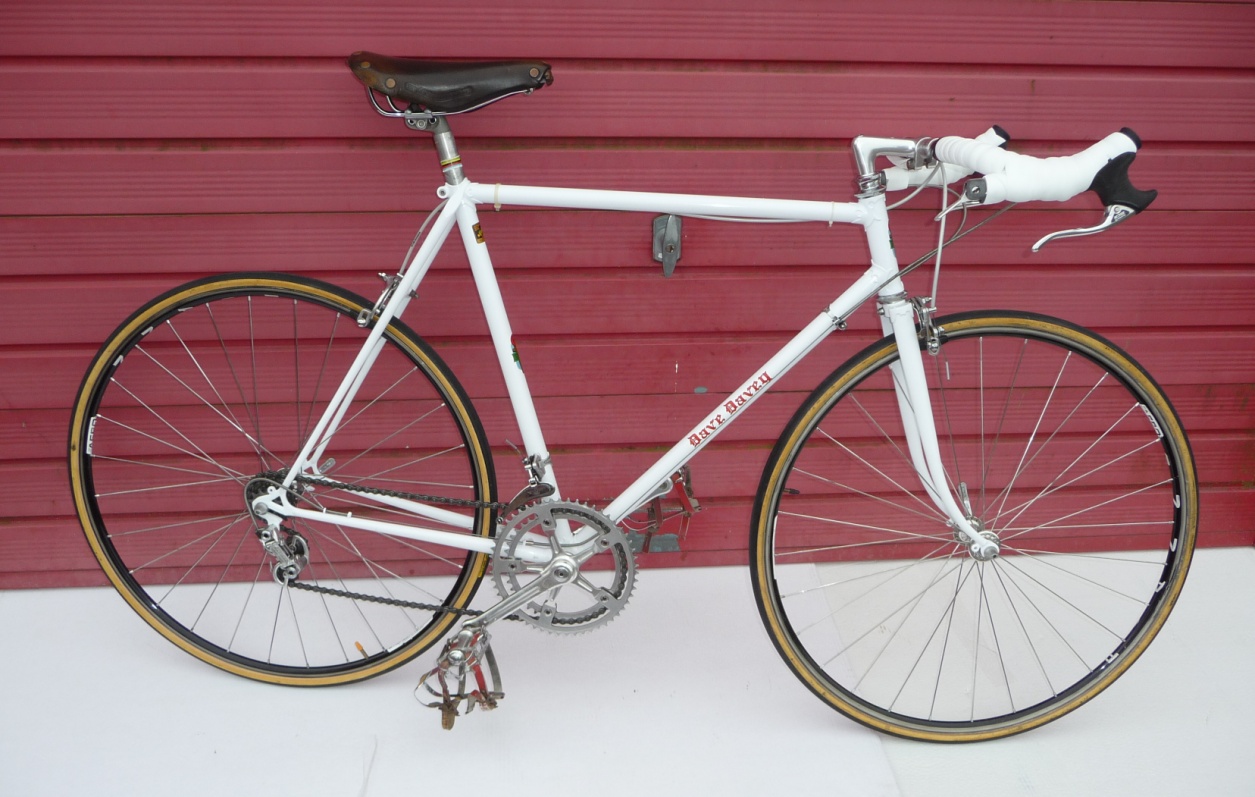
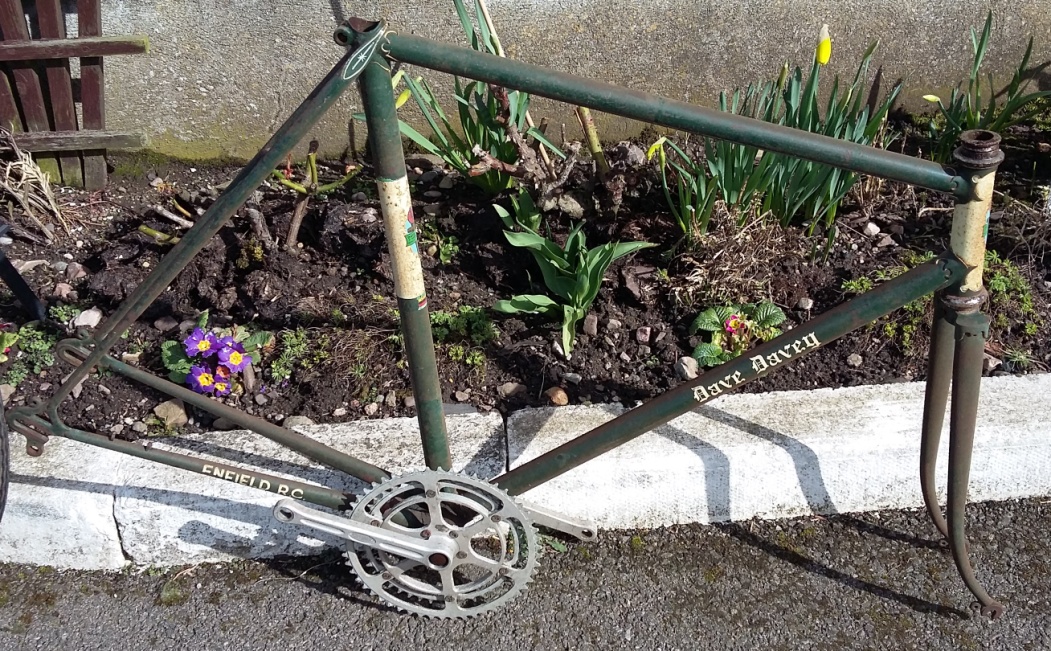
Current Equipment Details:
- 170mm Campagnolo Strada (1969) alloy cranks with matching 54 / 44t chainrings;
- Campagnolo (1969) road pedals with Christophe clips and straps;
- Campagnolo Nuovo Record (1969) front (CGF1C) and rear changers with handle bar control and S/S cabling;
- x’’ (90mm) Cinelli alloy stem (1969 Allen key style) with 400mm wide x 175mm reach Cinelli TTT alloy bars;
- Campagnolo (1969) alloy seat pillar;
- Brooks Professional saddle (1968);
- Universal Super 68 (1969) side pull brakes with Q/R and Shimano (1989) levers;
- Wheels – Suntour Spirit Small Flange Quick Release hubs, 28 / 28 aero profile S/S spokes on Pete Matthews-built Pianni Aero Sprint rims with Continental Giro rear and Vittoria Kelvar front tubulars. Currently fitted with 6 speed (12/13/14/15/17/19) TT event close ratio block.
I still have the original 1969 Cinelli Drop Bars and original 1969 Universal brake levers (and wheel set) should I wish to take back to fully old school bike.
Posted: Friday 16th September 2016
This article appears in the following categories.
Upcoming Events
Whether you are looking for a gentle social meet up, or a 100-mile ride browse the community’s upcoming events and plan your next weekend outing.
